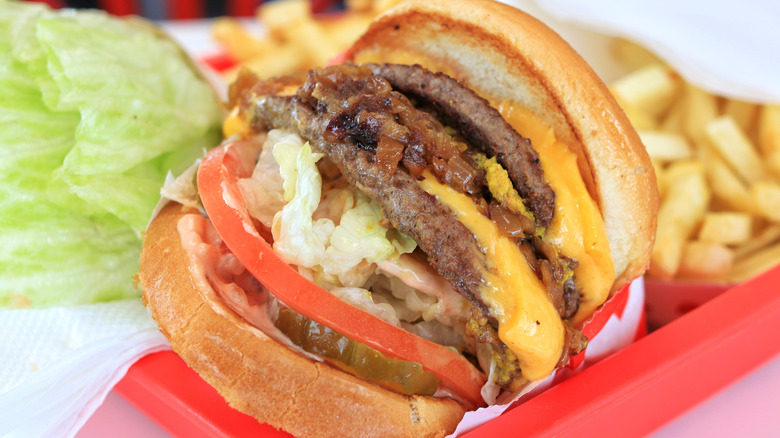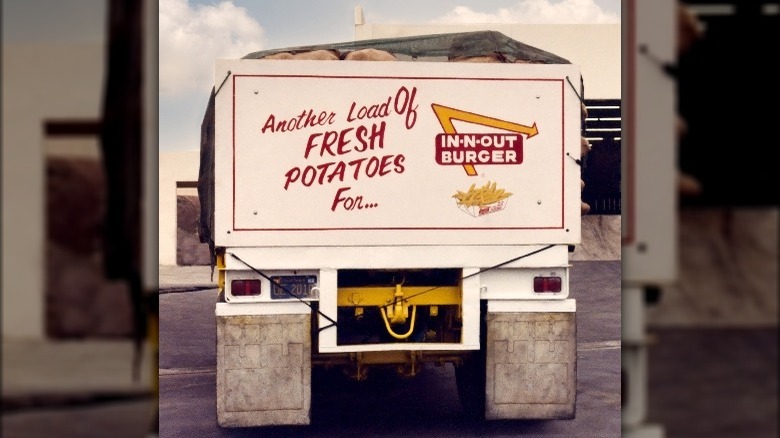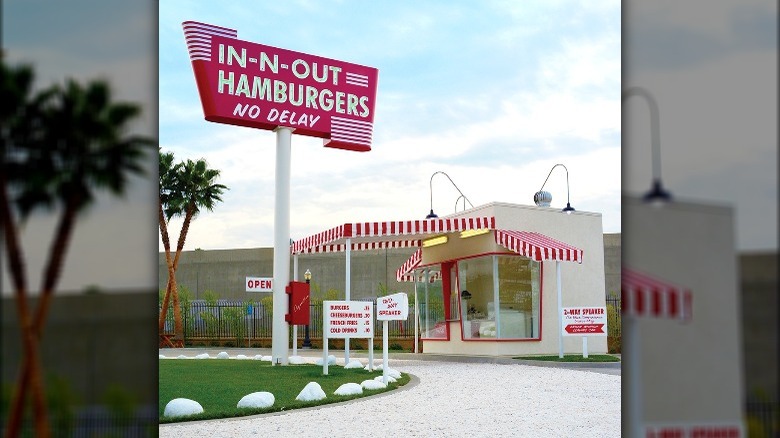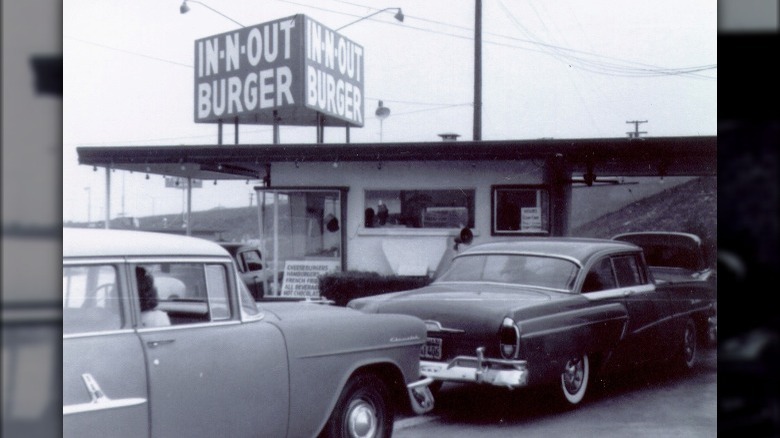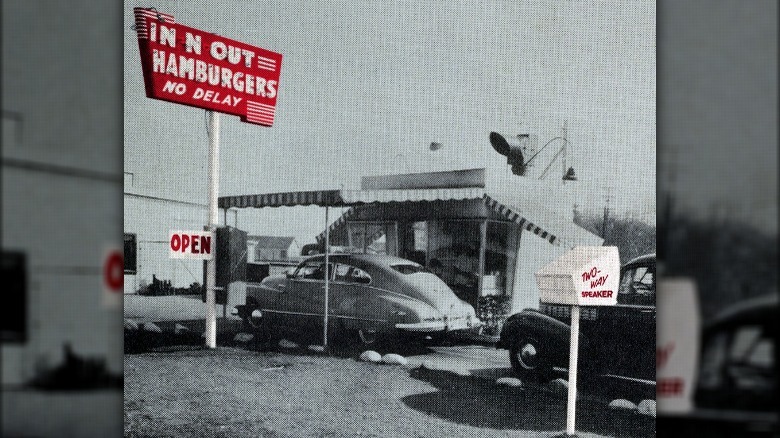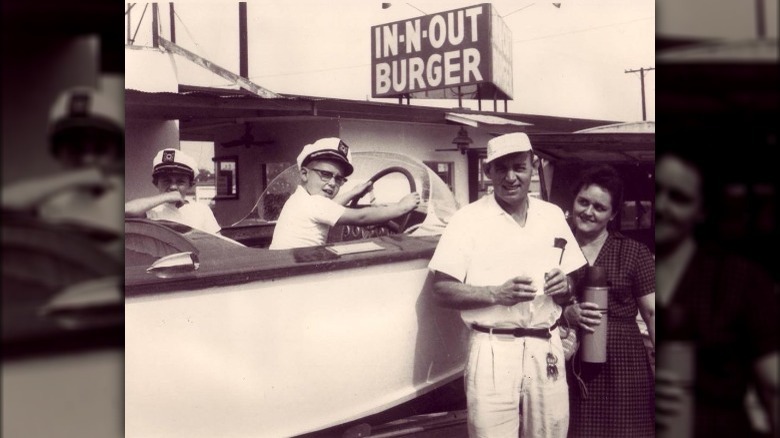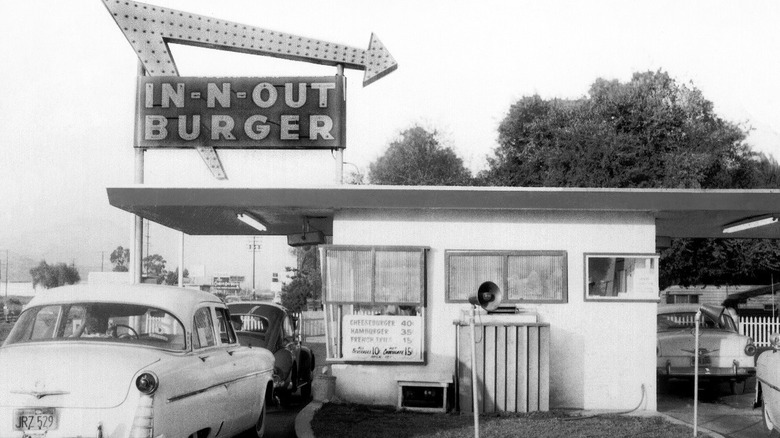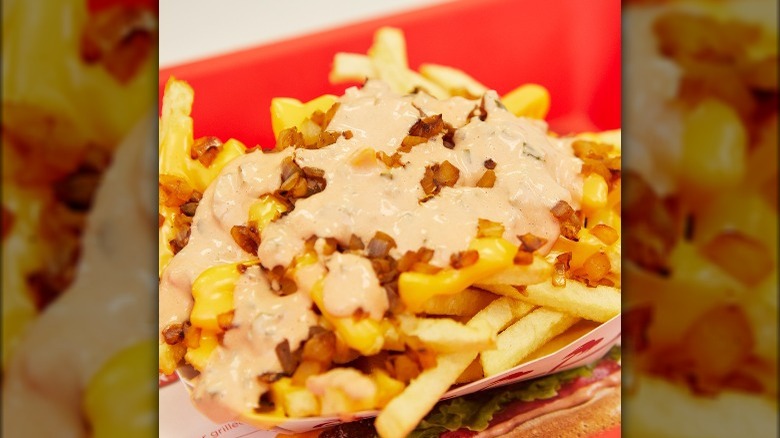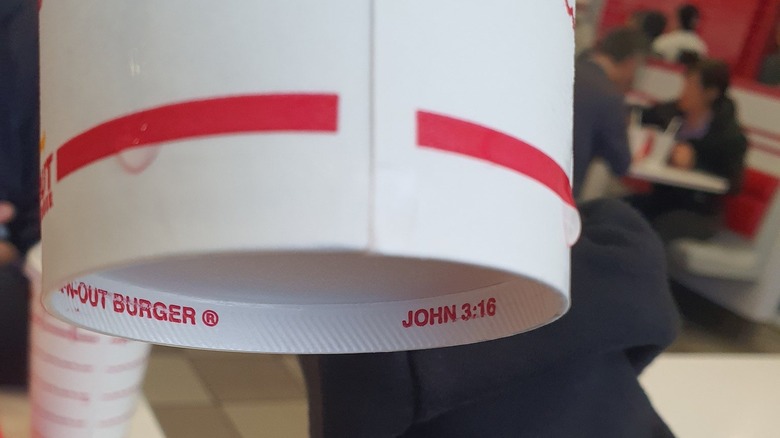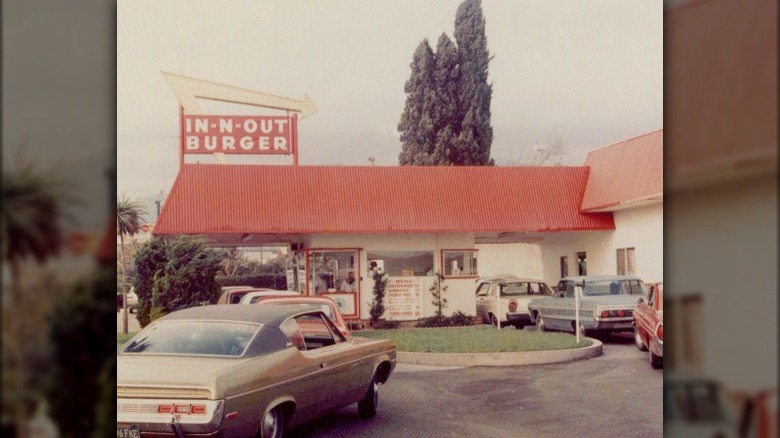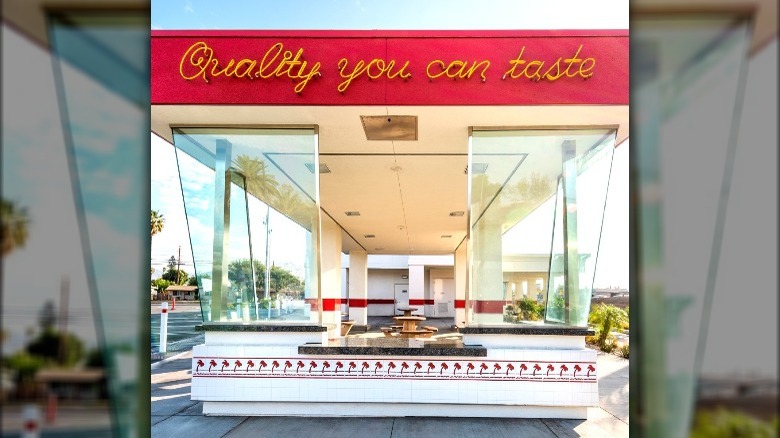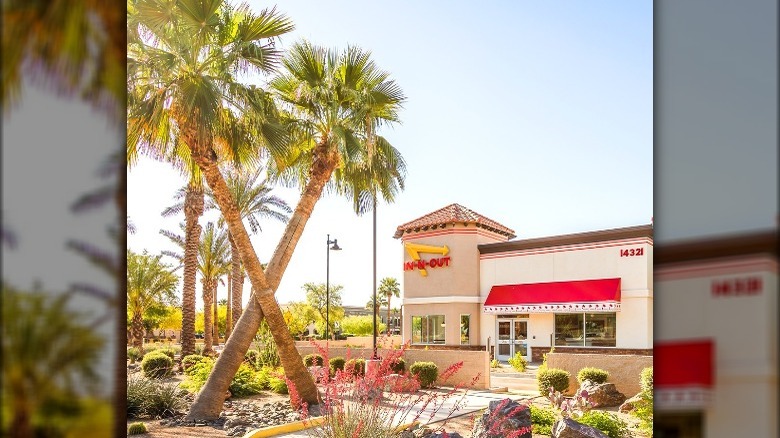What It Was Really Like To Eat At The First In-N-Out Burger
For those who live outside of the Golden State, there are few things that are as quintessentially Californian as In-N-Out Burger. In California, it is simply one of many burger options when grabbing a bite to eat — though there does seem to be at least a little bit of hometown pride when ordering your Double-Double with Animal Style french fries.
In-N-Out has deep roots in California, with the first location opening its doors on October 22, 1948, in Baldwin Park (via KCET). In fact, the story of the first In-N-Out seems like something straight out of classic Hollywood films: A newlywed couple chose Southern California to start their first business with no previous experience, but plenty of hopes and dreams, only to grow the burger stand into a bit of a regional empire with an almost cult-like following (via Gear Patrol).
But every successful restaurant chain has to start with its original location, so let's take a trip back in time to the 1940s and see what it would have been like to dine at the very first In-N-Out Burger.
You would have eaten very fresh ingredients
Fast food chains have drawn criticism over the years for adding unnecessary ingredients to their products, from preservatives to fillers and artificial flavoring. Controversial ingredients like monosodium glutamate (MSG) (via Healthline) and artificial food coloring (via Healthine) are prevalent in many fast food restaurants, with a growing number of customers becoming wary about how much consumption is healthy. More recently, fast food chains like Panera Bread have pushed to remove some of these ingredients (via Food Business News), but In-N-Out has been ahead of the pack since day one.
Even in the present day, In-N-Out prides itself on serving fresh ingredients to its customers. But this practice dates all the way back to the chain's earliest days, when the owner and co-founder Harry Snyder would visit the local meat and produce markets every morning to source ingredients to be used in the kitchen that afternoon. According to In-N-Out's website, Snyder would then prepare each burger by hand.
These days, In-N-Out produces its own burger patties from one of three facilities in Baldwin Park, California; Lathrop, California; and Dallas, Texas. The freshness extends to the lettuce, cheese, and other ingredients, which In-N-Out claims are never frozen or microwaved. According to Insider, this commitment to quality ingredients is part of the reason why the chain is in such a tight geographical location. To ensure freshness, all In-N-Out restaurants must be within a 300-mile radius of one of the three facilities mentioned above.
Its now-iconic arrow logo was not around yet
Logos are a crucial part of a brand's identity, and In-N-Out's is no exception. When you drive up to an In-N-Out today, you might immediately spot some recognizable branding imagery, from the criss-crossing palm trees to the red and white color scheme. But some of the restaurant's iconic signage did not emerge until several years after the chain first opened. The now-recognizable arrow was introduced in 1954, according to the company's website. Associates rallied around the arrow logo as a source of pride and camaraderie. According to Logos World, the arrow signifies two slogans that the restaurant has to this day: "We all work under the same arrow" and "The arrow points to pride." But before 1954, there was another rallying cry that customers would see immediately upon arrival.
When the restaurant first opened, the original logo had no embellishments and simply read "In-N-Out" Hamburgers (via Logos World). That used to be accompanied by an additional sign which read "no delay." According to History, the slogan was an easy promise for guests to wrap their heads around, and over time it became standard for customers to expect fast and reliable service. In present times, In-N-Out is tapping into the nostalgia of the early days, and you can now purchase "no delay" merchandise on its website, including t-shirts and baseball hats.
You would stay in your car to order (a huge novelty at the time)
The earliest customers were in for a huge shock when they pulled up in their cars. Up until 1948, there were only a few ways guests could experience fast food dining. The guests had to either walk up to the counter to order their food, or they would remain in their cars and be greeted by a carhop (via History). The latter was known as a "drive-in" dining experience, and it first appeared in the United States in the 1920s at a Texas chain known as the Pig Stand. In 1931, a Los Angeles location took the process a step further by introducing a method of drive-in dining that allowed customers to both order and pick up their food from a window with an employee — though it was unclear whether the customers had to step out of their vehicles at any time in the process.
In-N-Out continued the development of the drive-in dining experience by making its ordering process completely drive-thru, meaning the customer did not have to step out of their vehicle once. Drive-thru dining took a while to catch on, as many saw it as laziness on the part of both the customer and the business. These mixed sentiments were likely why it took a few more decades for drive-thru dining to catch on, as the fast food giant Mcdonald's did not introduce its drive-thru model until the mid-1970s.
You would interact with a two-way speaker box for the first time
Harry Snyder wanted to provide more than the convenience of allowing his customers to remain in their cars — he also wanted to completely revolutionize the drive-in experience. According to In-N-Out's website, Snyder had been developing a unique two-way radio speaker box system in his garage in the years leading up to the restaurant's grand opening. When the opening took place in 1948, Snyder's speaker box device was a central part of the guest experience. No longer did guests have to be waited on by a carhop when ordering their food; they simply drove up to the speaker box instead. It was an instant hit and the intercom system blazed the trail for what we know today to be drive-thru dining (via Gear Patrol).
The two-way radio system changed the way customers dined, because they no longer had to get out of their car to order their food, nor did they have to pull up to a window to speak to an employee directly. Instead, they could order their meal by speaking to the speaker box from their car and then proceed to pick their food up from the window. In addition to Snyder's speaker box system, In-N-Out was known for providing no indoor seating or parking for vehicles, all but forcing customers to drive in and out — thus embodying the restaurant's namesake (via History.com). The drive-in experience was now completely "drive-thru."
The only two employees you would see were also the owners
In-N-Out had very humble beginnings before it grew into the iconic California-based chain we know and love today. The restaurant was founded by newlyweds Harry and Esther Snyder barely one year after the two met in Seattle, Washington (via KCET). Perhaps marrying someone and opening a business with them is not what most of us would think about doing within a year after meeting someone, but Harry and Esther set their sights on Southern California and never looked back.
When the restaurant first opened, Harry and Esther were the only two employees. Harry would work at the restaurant preparing the menu items and serving customers while Esther would keep track of the finances and make sure the business was operating smoothly. Eventually, the Snyders began hiring additional employees, but it was done in a very deliberate manner so that their workers were treated like family. According to KCET, many of the employees would remain at In-N-Out for their entire careers. To this day, the chain is highly rated as one of the top dining establishments to work for with remarkable rates of employee satisfaction, according to Business Insider. The company also ranked number 39 on Glassdoor's 100 Best Places to Work in 2022.
Its menu was as simple back then as it is today
You know those times when you pull up to a drive-thru restaurant only to be stuck behind a car that seems to be taking all day ordering the entire menu? In-N-Out all but eliminates this problem by keeping its menu simple, almost to a fault. If you do not enjoy hamburgers, french fries, and milkshakes, you may want to dine elsewhere, because that is essentially the entire menu.
In-N-Out's famously small menu has always been straightforward and to-the-point. When the first location opened in 1948, it only served hamburgers, french fries, and soft drinks (via KCET). The simplicity removed a lot of the guesswork for customers, further emphasizing the convenient "in and out" nature of dining there. While a few additions to the menu were introduced over the years (including its now not-so-secret menu), it has more or less stuck to those key food items. According to Forbes, as of 2018, competitors Mcdonald's and Burger King sold more than 80 menu items, whereas In-N-Out sold less than 15 items.
In-N-Out is always listening to customer feedback, and some of the biggest changes to the menu came directly from guest requests. The Double-Double burger, for example, was offered to guests starting in 1963 before becoming a permanent fixture on the menu (via In-N-Out's website). According to In-N-Out, milkshakes were not added to the menu until 1975, though malts had been served for about a decade before that.
You would not find anything served Animal Style on the menu
Over the years, customers began coming up with unique ways of modifying their orders, from adding extra patties and cheese to smothering their french fries with In-N-Out's tasty burger spread. But if there is any modification as famous as In-N-Out itself, it has to be its Animal Style customization. But if you were to visit the first location in 1948, you would not find a single Animal Style item on the menu.
Like most menu additions, the Animal Style hamburger (which is now a trademarked term for the restaurant chain, according to Gear Patrol) was brought about due to customer demand. It is worth pointing out, for those of you who are perhaps new to this fast food chain's culture, that Animal Style means something different depending on if you are referring to hamburgers or fries. The Animal Style Burger, introduced in 1961, involves a method of mustard-cooking the beef patty before adding lettuce, tomato, pickle, grilled onions, and extra spread (via In-N-Out's website). Animal Style fries, on the other hand, involve covering your order of fries with burger sauce, onions, and melted cheese.
While the prevalence of Animal Style fries is widely known among the chain's enthusiasts, what's in In-N-Out burger sauce (known as its "spread") remains a mystery. Most have deduced that it is similar to Thousand Island dressing, but the exact proportion of ingredients has not been disclosed by the chain to this day.
There were no Bible verses on the products at the time
Have you ever taken the time to look under your cup of soda? Perhaps not, as that would be a peculiar thing to do with a fountain drink. But next time you dine at an In-N-Out, check out the little details on your food's packaging.
Fans of the fast food chain may already be well aware of the fact that the packaging has been embellished with select Bible verses. In fact, you will notice a different Bible verse depending on what food item you order. Everything from burger wrappers to cups cite passages from the Bible. Its soda cups read "John 3:16," the water cups read "John 14:6," and the milkshake cups read "Proverbs 3:5."
While the Snyder family was known for its strong religious beliefs, the Bible verses were not a part of the food packaging in 1948. This change came about in the 1990s, according to a People Magazine interview with In-N-Out President and heiress Lesli Snyder, Harry and Esther's granddaughter. Lesli Snyder mentioned that it was her uncle Richard Snyder who added the Bible verses to the food packaging as a way to express his newfound faith shortly before passing away. Originally, the Bible verses were only on a select few items, but Lesli Snyder noted that she continued to add the verses to more items over the years as a way to keep the family touch in everything the company does.
You could buy everything on the menu for under $1
It may be hard to think of a time when our everyday necessities costed mere pennies, but taking a look at old menus and other price tags from decades past will give us a glimpse into the cost of living at the time. When In-N-Out opened its first location in 1948, the price of one of its hamburgers was 25 cents (via San Gabriel Valley Tribune) — or $3.07 when adjusted for inflation in 2022 (via U.S. Inflation Calculator).
In fact, according to the San Gabriel Valley Tribune, if you were to add up the few menu items available at the original In-N-Out at the time the location first opened, you could drive away having spent less than one dollar. In addition to its 25-cent hamburgers, a cheeseburger cost 30 cents, french fries cost 15 cents, and soda was 10 cents. That brings the grand total to a whopping 80 cents (or less than $10 in 2022 when accounting for inflation).
Though times have changed and prices have gone up, one could argue that In-N-Out menu items remain fairly priced. According to Fast Food Menu Prices, a single cheeseburger costs $2.40, and a cheeseburger meal combo (with fries and a soft drink) costs $5.65, though prices may vary locally.
Drinks were served in a bottle, not via fountain
In addition to the development of the drive-thru system and the invention of the speaker box, another innovation that changed the way customers experienced fast food dining was the soda fountain. According to Thought Co., the soda fountain was first patented back in 1819, and by 1903 it was relatively common for someone to enjoy a carbonated beverage thanks to these devices. However, despite the popularity of soda fountains in the first half of the 20th century, the original In-N-Out did not include such a machine.
Whether it was to save on cost or personal preference, your beverages at the first In-N-Out would have been served in bottle form. According to its website, the soda fountain was not introduced until 1958, ten years after the first location opened. At that point, you could order from a variety of sodas, including Pepsi Cola, Nesbitt Orange, and Hires Root Beer. Nowadays, fountain drinks are abundant on the In-N-Out menu, including its popular pink lemonade.
You would not have to wait long for the second location to open
If the success of the original In-N-Out location was any indicator, it would only be a matter of time before additional burger stands began popping up around Southern California. Just three years after the first location opened, a second would open in 1951 in Covina, California (via KCET). According to the company website, by its tenth anniversary in 1958, there were five locations in the region. By 2018, the company rang in its 70th anniversary with well over 300 locations across six states, and a couple of years later in 2020, In-N-Out would open a location in its seventh state, Colorado.
The company's growth was impressive but also closely monitored and controlled by the Snyder family. Since the company refused to buy anything on credit, expansion happened perhaps a bit slower than its competitors. In-N-Out also refuses to franchise, a business decision that it follows to this day (via KCET). And while In-N-Out could likely expand to the East Coast, its owners are aware of the immense burger competition it would run into east of the Mississippi. Adding more locations outside of its distribution region could also loosen its quality control (via Business Insider). For now, In-N-Out will continue to remain a Western-exclusive chain, with its alluring criss-cross palm trees beckoning us all the moment we step off the plane at LAX.
